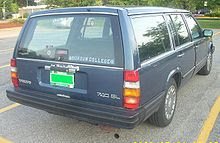The most visible differences between the 700 and the 900 series were the more rounded corners on the body of the latter, and a somewhat better-appointed interior. The 960 was substantially revised for the 1995 model year, improving the handling. The range was first augmented and finally supplanted by the Volvo 850 in 1993, with the last of the 900s being sold in 1998. Some 900 series were built as chassis for ambulances and hearses after the main production run had been completed. he 760 was Volvo’s attempt to cement a place in the prestige market, after building a reputation for being solid and safe rather than out-and-out luxurious cars. Jan Wilsgaard, head of Volvo’s Design and Styling team, proposed over 50 new designs for the new car. It was introduced to the US in 1982 for the 1983 model year as the 760 GLE sedan. This new design was criticized by the media when released: Gordon Murray of Autocar Magazine said, “To me it’s obscene! That goes right against the grain of what everybody else is trying to do. To me it looks like a European version of a North American car. It produces the same amount of power as a 2600 or 3500 — in this day and age it disgusts me to see something about like that. It’s a definite step backwards.” All that changed however when Autocar and Car & Driver got their hands on a turbo intercooled 760; they said it was one of the best handling and fastest accelerating cars they had seen in a while, thundering from 0-60 mph (97 km/h) in under 8 seconds.[citation needed]
1984–1985 Volvo 760 Turbo sedan (Australia)
Turbocharged and intercooled variants were added in 1984, station wagon variants and the 740 – the 760’s lower-specification sibling – were introduced for the 1985 model year. In 1985 Electronic Traction Control system was introduced. For the 1988 model year, the 760 received numerous updates. From the outside, the most noticeable of the over 2,000 changes were the revised front sheetmetal, including an aluminium hood, recessed windscreen wipers, and new aerodynamic headlights. Inside, all 760s were equipped with a new electronic climate control (ECC), a revised dashboard, three-position tilt steering, and a new stereo system. Underneath, sedans received the same multi-link independent rear suspension that was used on the 780.[1] Along with the revised dash, the interior saw the addition of a revised dome light and many fabric accent pieces.
The Volvo 760 was also used as a police car in several countries. East German leader Erich Honecker also often used this Volvo in his governmental car pool.
For its final year of production, 1990, 760 sedans received tail lights in the style of the Volvo 780 (see below), and minor interior changes. The 760 was discontinued after the 1990 model year (with production ending on 27 June 1990), and was replaced by the Volvo 960, an evolutionary update of the 760 chassis. The Volvo 740 outlived the 760, remaining for another two years.
All 760s were built in Kalmar, Sweden, or Ghent, Belgium. 
During a challenge on the British television motoring series Top Gear, the team are given a challenge to purchase fully legal cars (with road tax and a valid M.O.T.) for less than £100, presenter Jeremy Clarkson purchased a Volvo 760 GLE, and won the overall challenge, mainly because his car cost only £1, and was the only car still working after a 30 mph (48 km/h) crash they had at the end.
Volvo 740

Introduced in the U.S. for the 1985 model year, the 740 was a more simply equipped version of the Volvo 760. The 740 was intended to be a mid-size car that offered more style, performance, and luxury than the venerable 200 series.
Volvo 740 wagon (US)
In the U.S., the 740  was offered from 1985 to 1992 as a 4-door sedan (known internally as the 744) and a 5-door station wagon (known internally as the 745). Production of the 740 ceased in 1992, though the engine, transmission, chassis, and other details lived on in the Volvo 940, which was essentially a re-skinned 740. Though out of production for over 15 years, the majority of these cars are still on the road today, thanks to robust construction and engines known to run for hundreds of thousands of miles.[citation needed]
was offered from 1985 to 1992 as a 4-door sedan (known internally as the 744) and a 5-door station wagon (known internally as the 745). Production of the 740 ceased in 1992, though the engine, transmission, chassis, and other details lived on in the Volvo 940, which was essentially a re-skinned 740. Though out of production for over 15 years, the majority of these cars are still on the road today, thanks to robust construction and engines known to run for hundreds of thousands of miles.[citation needed]
Volvo 700-series sedan (US)
In 1990 the 740 received a minor facelift with new composite headlamps and 780-style tail lights. In 1991, both the 740 and the newly introduced 940 received an updated dashboard, similar in appearance to the ones found in the 760. The 740 remained mostly unchanged for the 1992 model year, and was phased out in 1993 in favour of the Volvo 940.
Aside from styling, 1990 marked a number of mechanical improvements to the 740 series. The B230 motor received larger 13 mm (0.5 in) connecting rods. The 740 Turbo switched from the Garrett T3-series turbocharger to the Mitsubishi TD04 series, offering quicker spool-up and better low-RPM boost at the expense of top-end performance. The fuel system was upgraded from Bosch LH-Jetronic 2.2 to 2.4 (in 1988 for naturally aspirated cars, 1990 for Turbo cars). The newer fuel system offered onboard diagnostics, which are easily accessible from under the hood, and require no special equipment. In 1992, the final year for the 740, the mechanical engine cooling fan was replaced with an electric fan. In short, many of the mechanical lackings of the 1985-89 740s were ironed out in the 1990-92 model years. The 1990-92 Volvo 700-series cars may very well represent one of the most reliable 4-door passenger sedans of its era due to a limited number of engineering limitations and solid build quality.
Trim levels were GL, GLE and GLT worldwide; Continental markets had some exceptions to this rule. The most interesting exception was perhaps the 740 Turbo 16v sold only in Italy. This car used the B204FT engine found also in the 780 on the same market and it came with some unusual extras such as the ECC from the 760.
The Volvo 780 grand touring coupé made its debut at the International Auto Show in Geneva, Switzerland in 1985. It marked the return of a two-door 2+2 seater coupe to the Volvo stable after a four-year absence following the departure of the 262C in 1981. The 780 became available in Europe in 1986, and would come to the United States a year later.
Like its predecessor, the 780 was designed and built by Carrozzeria Bertone in Turin, Italy. However, unlike the Volvo 262C, the 780 was not merely a two-door 760 with a “chop top” roof. Bertone gave the 780 its own distinctive shape which set it apart from the other models, yet was still identifiable as a Volvo. The car had a sleek, low profile, inheriting some of the styling of the other 700 series cars, but without many of the severe angles and sharp corners. The hood, trunk, and roof lines were all slightly lower than the standard 700 series profile, and the C-pillar was wider and had a more gradual slope down to the trunk. Headroom was improved over the 262C, due to Bertone’s mere 1 cm lowering of the roofline. Window frames all had black matte trim, and were accented with chrome. Chrome also highlighted the door handles, bumpers, and side mouldings.
In the first two years the 780 was available worldwide (’86 and ’87) the 780 was available with the B280F V6 engine and a solid (live) rear axle. In the following year, they came equipped with Volvo’s independent rear suspension, which used self-leveling Nivomat shocks, to keep ride height correct.
Many people began to take note of the relatively weak powerplant that the 780 had.[citation needed] The B280F at this point had roughly 150 hp (110 kW), but the car itself was nearly 3,400 lb (1,500 kg). To address concerns over performance, Volvo introduced the B230FT+; a B230FT with Volvo’s boost controller, Turbo+, increasing the engine output to 175 hp (130 kW). The following model year saw it increase to 188 hp (140 kW). In Italy, 780s came with the B204GT. This was a 16 Valve Turbo motor producing 200 hp (150 kW). In the car’s final year, 1991, it was rebadged simply as “Coupé”. At this point, the car came only in turbo guise.
Volvo’s official production total for the 780 is 8,518 cars built between 1986 and 1991. However, this number has often been disputed as different sources[clarification needed] have often estimated the actual total to be higher. As before, a coupé would remain absent from Volvo’s model line for several years, until the front-wheel drive C70 was premiered in 1995 for the following model year.
Total production was more than 9,521 worldwide, but the exact total production is still unknown. 5,695 were imported to the US.




